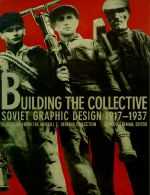BUILDING THE COLLECTIVE: SOVIET GRAPHIC DESIGN 1917-1937 |
|||||||
| Building the Collective deals with an absolute unity of purpose and message, one that came out of the turbulent, formative years of the Soviet Union. When the Bolsheviks seized power in Russia in 1917, they pledged a rapid and massive transformation towards a communist society. Faced with numerous competing political groups and interests, the fledgling government mobilized artists throughout Russia in an effort to win over the masses. As the book shows, early efforts were focused on the creation of posters, which soon became a ubiquitous part of the Russian landscape. Designers worked at a furious pace despite paper shortages and a scarcity of printing presses; it is estimated that by 1921, over 4,000 posters had been issued. Production was facilitated by the use of newly developed technology, such as the telegraph. The ROSTA poster-making collaborative, for example, transmitted concepts and text for posters to designers throughout Russia, who would churn out images overnight, or sometimes within hours. The growing influence of design attracted numerous artists of note such as El Lissitzky and Alexander Rodchenko, who questioned the validity of studio art within the new communist society. Their Constructivist æsthetic, which utilized angled lines, strong geometric forms and photomontage, became the dominant look in Soviet posters. However Building the Collective uncovers a greater variety of work produced during the Soviet Union’s early years, including book covers, magazines, factory interiors and packaging. In order to compete with private industry, state-owned factories packaged products with blatantly political messages that bordered on the extreme. For example, a cookie box designed by Rodchenko boasts “We are propagating the idea everywhere...even on the subject of sweets our will shall triumph.” Such translations accompany all the work reproduced in the book, so that readers may fully understand the messages contained within the Cyrillic text of the graphics. Building the Collective also includes preliminary sketches that reveal how concepts were developed and often manipulated. In one poster emphasizing worker solidarity, a photomontage shows Stalin at the head of a marching column of laborers. Although seamless in the printed piece, an early paste-up shows how the designer reworked a photograph to include the leader. Building the Collective is an excellent history that includes many rare examples of early Russian design. The book is as much about politics as it is about graphics, and as the reader will discover, during the formative years of the Soviet Union, both were inseparable. —Philip Krayna |
|
||||||
Building the Collective: Soviet Graphic Design 1917-1937 Editor: Leah Dickerman Publisher: Princeton Architectural Press/Chronicle Books [1996] ISBN: 1-56898-074-4 Binding: Paperback, 128pp, 10 3/4" x 8 1/4" |
|||||||
© Copyright 1997–2002 TypeBooks |
|||||||
